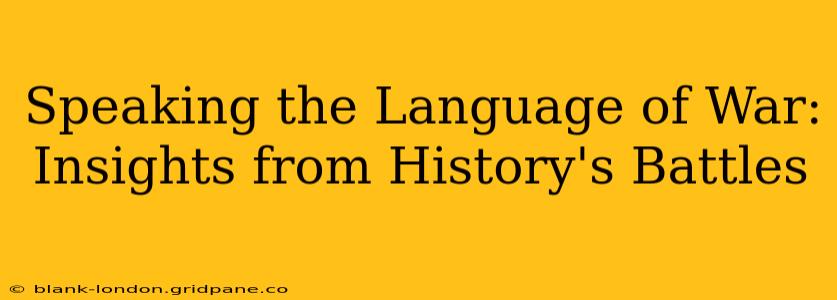War, a brutal and complex phenomenon, is far more than just clashes of armies. It's a tapestry woven with threads of communication, strategy, and psychological warfare. Understanding the language of war – the coded messages, the strategic pronouncements, and the subtle shifts in rhetoric – offers invaluable insights into its causes, conduct, and consequences. This exploration delves into historical battles, revealing how communication shaped the course of conflict and offering a deeper understanding of this enduring human struggle.
How Did Communication Affect the Outcome of Major Battles?
Communication, or its lack thereof, has been a decisive factor in numerous battles throughout history. Consider the Battle of Waterloo (1815). Napoleon's inability to effectively coordinate his forces due to poor communication and the challenging terrain contributed significantly to his defeat. Conversely, the Allied forces, utilizing a more robust communication system, were able to better synchronize their attacks, exploiting Napoleon's weaknesses. The speed and reliability of communication directly impacted battlefield effectiveness and ultimately, victory or defeat. The use of semaphore flags, signal cannons, and later, the telegraph, dramatically altered the pace and scope of warfare. Swift communication enabled rapid responses to changing battlefield situations, allowing commanders to adapt their strategies in real-time.
What Role Did Propaganda and Psychological Warfare Play in Historical Conflicts?
Propaganda and psychological warfare are integral aspects of the "language of war." From ancient times, leaders have sought to manipulate public opinion both domestically and internationally to gain support for their war efforts or to demoralize their enemies. The Allied propaganda campaigns during World War I and II are prime examples, effectively swaying public opinion and maintaining morale. These campaigns weren't just about disseminating information; they were about shaping narratives and creating emotional responses that could influence the outcome of the war. The effectiveness of propaganda, however, hinges on credibility and the ability to resonate with the target audience. False or exaggerated claims, if exposed, can backfire spectacularly.
How Did Military Strategy and Tactics Evolve Based on Communication Advances?
Technological advances in communication directly influenced the evolution of military strategy and tactics. The development of the radio, for instance, revolutionized battlefield coordination during World War I and II. Real-time communication across vast distances allowed for coordinated offensives and defensive maneuvers with unprecedented precision. This led to new tactical formations and the emergence of combined arms warfare, integrating various branches of the military (infantry, artillery, air power) through seamless communication networks. Modern warfare is heavily reliant on satellite communication, enabling global reach and precise targeting, leading to even more sophisticated strategies and tactics.
What Communication Challenges Did Commanders Face in Different Eras of Warfare?
Commanders throughout history faced unique communication challenges depending on the era and technological capabilities. In ancient times, reliance on messengers and signal fires meant slow and unreliable communication. This often resulted in delays, misinterpretations of orders, and fragmented battlefield actions. The Napoleonic era witnessed improvements with the use of semaphore and signal cannons, but these systems still had limitations in terms of range and speed. The advent of the telegraph during the 19th century represented a major leap forward, yet issues of security and access remained. Modern warfare's reliance on complex electronic systems introduces new challenges – vulnerabilities to cyberattacks, jamming, and the need for strict information security protocols.
How Has the Language of War Changed with the Rise of Social Media?
The 21st century presents a new battlefield in the realm of information warfare, heavily influenced by social media. The speed and reach of social media platforms have significantly altered the dynamics of communication during conflicts. Information spreads rapidly, sometimes bypassing traditional media outlets. This creates new challenges in terms of countering misinformation and propaganda, managing public perception, and maintaining operational security. Simultaneously, social media offers new avenues for communication and mobilization, both for military organizations and civilian populations. However, navigating this complex digital landscape requires careful strategies to ensure accurate and timely dissemination of information while mitigating the risks of misinformation and manipulation.
This exploration merely scratches the surface of this multifaceted topic. Further investigation into specific battles and conflicts, along with an examination of the underlying sociological and psychological factors, will provide even richer insights into the enduring power of communication in the language of war.

